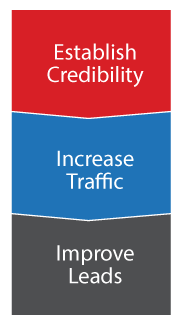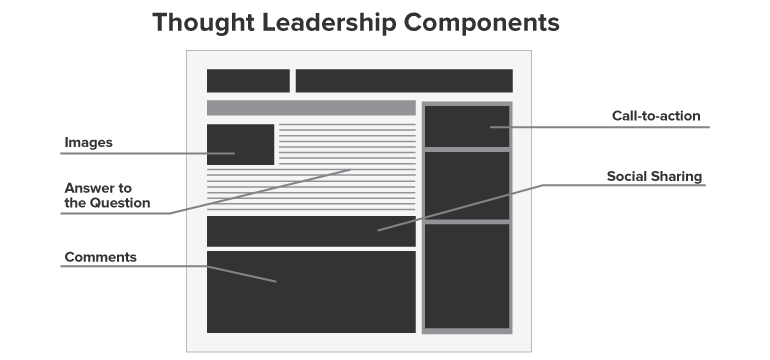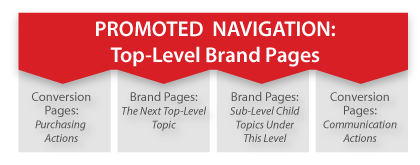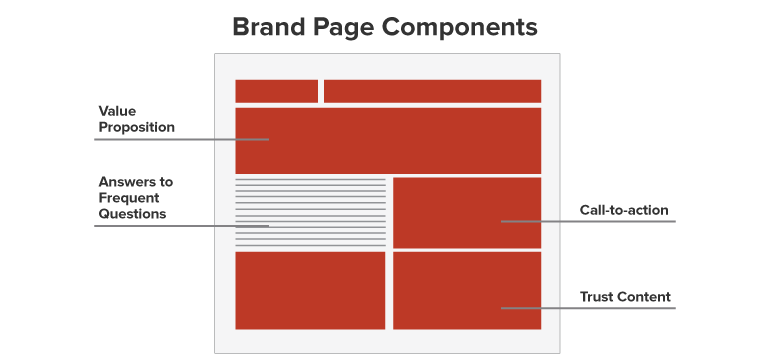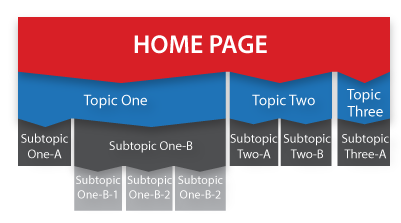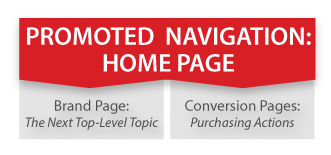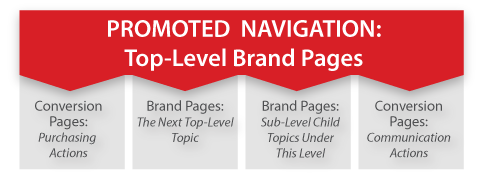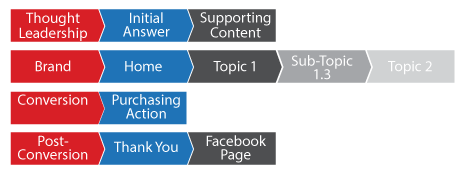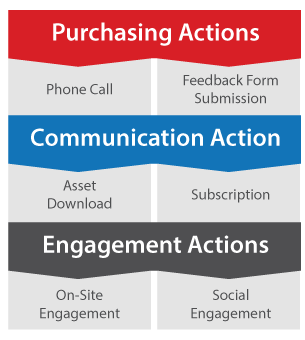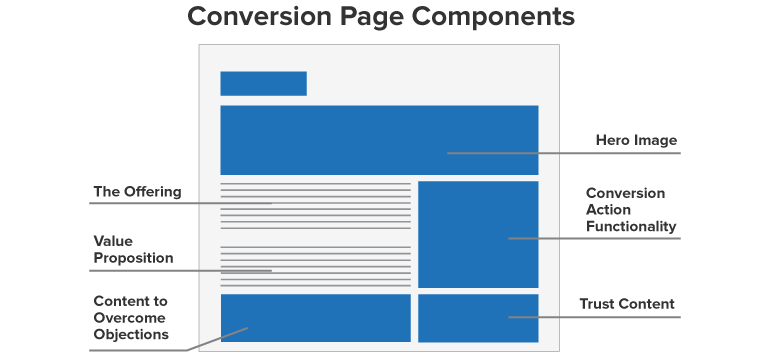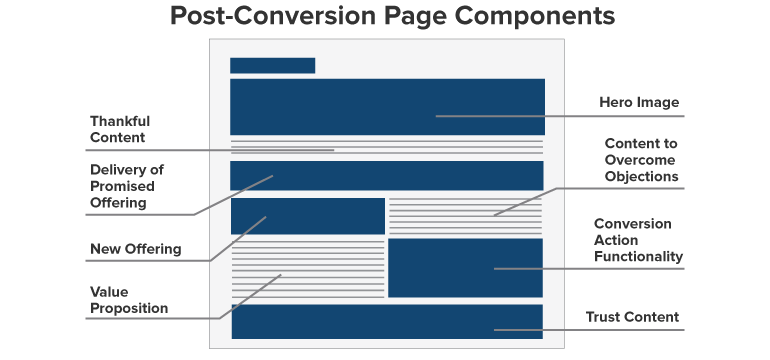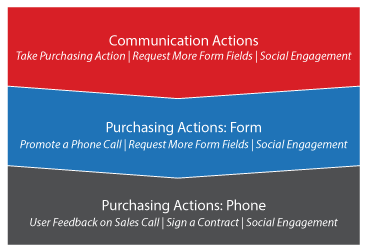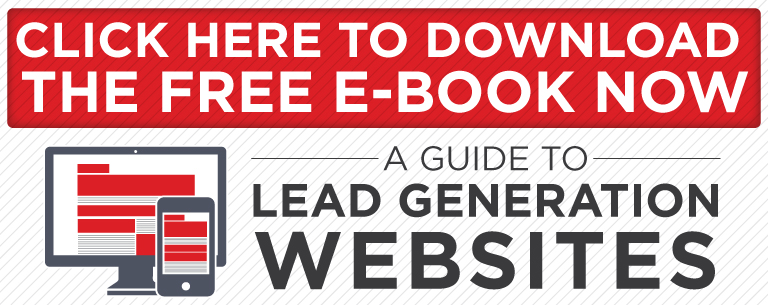Table of Content
Introduction
As an Internet marketing agency, we found ourselves ‘reinventing the wheel’ over and over again when planning out the structure and message of websites. Over time, we realized that we were actually going through a very similar planning process for each site. Even within a single vertical, we still wasted hours of valuable time planning website hierarchies that seemed to end up very similar. Looking back, it is clear that we had created an informal ‘formula’ for the creation of high-converting, lead generation websites.
This guide is an outline of best practices, and how you can use them as a formula to create your own lead generation website. By following this guide you will be able to move your visitor forward through the conversion process, shorten the time to sale, and increase overall conversion rates.
The Four Types of Pages
First, let’s talk about the real ‘meat’ of any website; its content. Your high-converting website will be created and designed with four distinct types of web pages, each with a specific purpose.
The four types of pages on your website are:
- Thought Leadership Pages
- Brand Pages
- Conversion Pages
- Post-Conversion Pages
Thought Leadership Pages
Thought leadership pages generate the majority of the organic traffic to your site, and also establish credibility with your target market. This credibility improves your rankings in the organic search engines, and it improves the number and quality of leads you are able to generate on your website.
Thought Leaders Answer Important Questions
Thought leadership is established when your target market thinks of you or your business as the source for the best answer to their most important questions as they relate to your brand. Your market determines what they are interested in, and it’s up to you to answer their questions. If you want to become a thought leader in their minds, you have to earn it.
Thought Leadership Pages are Entrance Pages
The portion of your website that establishes you as a ‘thought leader’ are also the pages on your site where most of your market will first land, or ‘entrance pages’. These pages should be written and designed specifically to both answer the questions of your market, and appeal to that market as a credible source of information. Do this, and your visitors will return when they need more information. They will link to your site and share your site with their peers, and they will have greater trust in your brand.
The best way to drive traffic to your site is by creating pages with two purposes:
- Answer a question important to your potential clients
- Generate inbound traffic to your website
The Old Way – Legacy SEO Pages
There was a time when webmasters would create page headings exactly matching the search phrase for which they wanted to rank in the search engines. In the addiction treatment industry you can still see pages for almost any relevant key term that have a title, URL, and heading that exactly match the phrase that the page is being optimized for. We refer to this type of page as a ‘legacy SEO page’.
The New Way – Blogs
Today, in most cases, thought leadership content should be published on a blog or in a separate and dedicated section of the site. Regardless of where the content is published, it needs to be designed and published in a way that maximizes its benefits as an informative page that builds brand trust and credibility, as well as optimized as an entrance page to the site. Pages created specifically for this purpose should be continually added to the site to keep feeding your visitors new and interesting content.
Invest In Big Content
Historically, ‘big content’ created with a focus on quality provides a greater return on investment than shorter articles. Make the extra effort in research and quality of presentation. In the long run, it’s more than worth the investment.
Thought Leadership Page Components
Create a standard format for your Thought Leadership pages to improve your visitor’s ability to find the information they are looking for. Sometimes different types of content will need different layouts and formatting, but you definitely want to try to keep these pages laid out as similarly as possible. Your visitor will only have to learn the layout on the first page, and then finding information from then on will be much faster for them.
Your Thought Leadership pages should include the following components:
- Images
- Answer to the Question
- Calls-to-action
- Social sharing buttons
- Comments
Images
Use a featured image at the top of your post that is interesting. Focus less on making this a perfect match to your content, and more on finding an image that will motivate your visitors to read your post.
Make sure that your images are in-line with the positioning of your company (who you are to your market), and with the voice of the content. If it’s a formally written document, choose a formal image. If it’s a conversational piece of content, then use a less formal image.
Answer the Question
This is the main body of your content. Make sure, above all else, that the content effectively answers the visitor’s question. Take extra time to make sure that the content is ‘skimmable’ by adding headings and subheadings to break up the content.
Calls-to-Action
Your Thought Leadership pages answer the questions that the visitor came to your site to have answered, but in doing so you will probably create even more questions that they will want answered. Offer them answers to these questions by converting, which provides them with more value but this time they will have to give some value back (in the form of contact data).
Promoted Conversions
The conversions that you are promoting need to be the right conversions for where your visitors are in their exploration process, which is right at the very beginning. Since you are establishing yourself as a thought leader, you should promote conversions that enhance this trust and move visitors closer to wanting to learn about your brand.
In your calls-to-action, promote your Communication Action conversions on your Thought Leadership Pages, but also allow visitors who aren’t ready for that yet to take smaller steps. In a less prominent way, promote Engagement Actions, and lower-value Communication Action conversions to allow those visitors who aren’t ready to take a Purchasing Action to take a smaller step.
Note: The types of conversions and conversion types, including Communication Actions and Engagement Actions, will be covered in detail later.
A good example of a relevant Communication Action on a Thought Leadership Page would be to allow the visitor to download an e-book that gives in-depth detail about a topic that a few blog posts have covered. Cheat-sheets, worksheets, and e-books that consolidate several blog posts are great ideas for high-value Communication Action conversions.
Make sure that you also encourage your visitors to subscribe to your newsletter or blog, and to leave comments regarding the post they have just read. A great way to encourage commenting is to ask a question as the closing sentence in your blog posts. Also, post a comment yourself, and ask your team and colleagues to comment. Once you get a conversation started others will want to join in.
Social Sharing Buttons
It builds credibility in your content and in your business when visitors see that your content has been repeatedly shared by others who have enjoyed it. These social signals help drive traffic, and increase conversion rates. Also, when your content is shared on your visitor’s social profiles, you gain all the extra exposure to their social network.
Comments
Make sure that you enable comments on your site. Engage your visitors, allow them to create content and participate in a conversation. Whether you use a third-party to handle your page comments, or it’s built into your content management system, allowing comments on your Thought Leadership Pages is a good idea.
Promoted Navigation
Thought leadership pages should include links to (in order of prominence):
- Complementary Thought Leadership content
- Relevant conversion actions
- Links to relevant brand pages
Link to Supporting Thought Leadership Pages
Linking to other thought leadership pages is something that you should do with the purpose of better educating your visitor and providing them with the best answers you can. This is you giving them something for free: information. They might not realize right away that they are receiving something for free, but if you answer their questions they will immediately appreciate you for it.
Link to Relevant Conversion Actions
Thought leadership pages are an opportunity to provide your visitors with answers and education. Visitors don’t land on thought leadership pages to purchase or even to learn about your offerings. They land on these pages to get answers to their questions. Give them those answers, and then try to take them to a tactful next step. You won’t want to try to get your visitors to take a Purchasing Action from this section of your site.
Promote conversions that make sense on these pages. Choose to promote relevant conversions that will strengthen your brand image; Communication Actions and Engagement Actions. Try to hit them for the Purchasing Action conversion, and your page instantly loses credibility. These three conversion categories will be covered in detail further on.
Link to Relevant Brand Pages
Linking to relevant brand pages is your way of nurturing interested visitors so they are closer to taking a Purchasing Action. Remember, we don’t want to hit them up for an actual Purchasing Action from Thought Leadership pages. Thought Leadership pages are your gift to them, so large calls-to-action that promote a Purchasing Action won’t sit well with your audience.
You want to be very careful that you primarily use links to Brand Pages as references that reinforce your content, and only when extremely relevant to the article. These are not calls-to-action. When in doubt, leave this link out.
Brand Pages
Now that you have attracted a visitor to your website, and have established credibility with your high-quality content, it’s time to impress them with your brand. The pages on your site that take the visitor from their initial visit to a converted lead (the ‘Convert’ phase of the Digital Marketing Lifecycle) are the pages that communicate your brand message to the visitor.
Answer Your Visitors’ Questions
The Brand Pages on your site should be specifically tailored to answer the questions that your potential clients have about your business and to strengthen your brand in their minds. For most business, the ultimate goal of Brand Pages is to motivate visitors into taking a Purchasing Action.
When a visitor decides that they want to move on from a generic Thought Leadership page to learn more about your business, you want to most aggressively promote the Brand Pages that your market is most interested in. This is congruent with our attitude that above all, we want to effectively answer the visitor’s questions.
After viewing any Brand Page on your site, visitors will typically want to either:
- Take a purchasing action.
- Learn more about your business offering
The structure and content of your Brand Pages is primarily determined by these two visitor desires.
Choosing Topics
In order to properly plan your Brand Pages, you first have to know what your market is most interested in, and which questions they need to have answered before they will take a Purchasing Action. This data can be found from multiple sources, and the process is typically very similar for all sites within an industry
Web Analytics Data
Start the process of determining what your visitors need before taking a Purchasing Action by looking in your Google Analytics (or other web analytics) account. Analyze the way visitors who convert currently flow on your site, and also look at the most popular pages. This data will be a little biased because your visitors can only see the content that’s currently on the site, and not necessarily the content that should be on your site, so keep that in mind as you work through the data. The idea is that you want to find out what your visitors need to before taking a Purchasing Action so that you can make sure the information can be easily found.
Visitor Surveys
To more closely determine exactly those topics that your visitors are interested in, without biasing your data with the existing website, try a visitor survey. There are several tools that offer user feedback surveys, but they all provide the same result: a better understanding of your visitor’s interest.
Typically, this is all you need to determine which topics your visitors are most interested in. Take those topics, and with a little refinement, you should have a list of 2 to 5 top-level pages for your new navigation structure. Rank these topics in order of visitor interest, and you have your top-level Brand Pages.
Brand Page Components
By including a standard group of content components on your Brand Pages you will be able to effectively give the visitor the information they are seeking. You should include the following pieces of content on every brand page:
- Your value proposition
- Trust-building content
- A call-to-action
- Answers to Frequent Questions
The Value Proposition
Displaying your value proposition is most effectively done with a combination of graphics and text. Try to tell a story that contains the problem, the solution, and the outcome. On the home page, this will be that value proposition of the business. On your topic pages, this will be the value proposition of that particular portion of your offering.
Refine how you present your value proposition so that it will resonate with your market. Consider the stories of your client successes. Theirs are the stories that will best showcase what you bring to the market.
Trust-Building Content
To build trust and credibility with your visitors you will want to display what others have said about your business. This may include:
- Who has covered you in the news
- Testimonials from satisfied clients
- Certifications, awards, and ratings
Adding these to your site will almost immediately increase conversion rates, especially if the visitor recognizes the name of the person talking about your business. Remember to place your trust-building content close on the page to your call-to-action.
Calls-to-Action
The point of every page on your site is to eventually turn your visitors into a lead or a paying client. Your calls-to-action should fit the message of the page, and be consistent in its message with the value proposition that you are also displaying on the page. Use words that focus on your customer (e.g. ‘you’ and ‘your’), and spell out what they can expect to receive or experience if they choose to convert.
Remember, the best way to make a sale is simply to ask for it.
Promoted Conversions
The conversions that you are promoting also need to be the right conversions for where your visitors are in their exploration process. Since they are being exposed to your brand, you should promote more valuable conversions.
In your calls-to-action, promote your Purchasing Action conversions on your Brand Pages, but also allow visitors who aren’t ready for that yet to take smaller steps. In a less prominent way, promote downloadable assets, and other Communication Action conversions to allow those visitors who aren’t ready to take a Purchasing Action to take a smaller step.
A good example of a relevant Communication Action on a top-level Brand Page would be to allow the visitor to download an e-book that gives in-depth detail about a feature of your offering.
Answer Purchasing Questions
This is all the rest of the content on your Brand Pages. Make sure that on every page you give the visitor the answers to their questions. Whether it’s compliance issues, lead time, or feature compatibility, you always want to make sure that they have what they need to make a decision.
Don’t put too much information in here. The idea is to give them only the information that they need, and to make sure you don’t overwhelm them by trying to feed them all the information you want them to have. Chances are you have more to say about your product than your visitors have time (or desire) to hear.
It’s easy to fall into the trap of writing about all the great bits of your business, right down to the finest detail. This will not make for a great visitor experience. If you must put every detail of your offering on your site make sure you move the detailed content into child pages. This will allow your visitors to have the option to get more information if they want it, and vastly improve their user experience.
The Brand Page Hierarchy
Your site will be structured in a hierarchy with your home page at the top. Under the home page will be top-level topics that are answers to broad questions, with links to sub-topics that answer more detailed questions within the topic.
Let’s say that we have these topics in order of importance:
- Topic One
- Topic Two
- Topic Three
As you add detail to the information on our site, you might be tempted to create a hierarchy that is quite deep. Try to avoid creating a topical hierarchy that is more than 3 levels from the home page. By doing this you keep your offering easy to understand, and you won’t overwhelm or confuse your market with nuances.
By following this protocol for structuring the Brand Pages on your site, your website hierarchy might look like this:
The Home Page
The home page on your website is where you showcase what your business is all about. Of all the Brand Pages on your site, your home page is the most important. Take extra care when communicating your brand and value proposition on this page. On top of the standard Brand Page components, make sure that clearly elucidate:
- Who you are
- What you do
- Who you do it for
Promoted Navigation
Your home page is an overview of your business as a whole, and is a snapshot of your positioning. Provide your visitors with a clear path to have their most important questions answered by linking to the first top-level topic in your site’s Brand Page hierarchy.
Top-Level Brand Pages
The answers to the questions that you determined (by reviewing your analytics and taking user surveys) are the most important to your market, become your top-level Brand Pages. These contain the answers to your market’s purchasing questions regarding your offering, and form the foundation of your website. You will need to create one page for each top-level topic.
Promoted Navigation
Your top-level Brand Pages offer broad answers, but sometimes visitors will want more information about the specific details of your product. Make it easy for your visitors to find these answers by including links to sub-topics of this page appropriately within your content.
Sub-level Brand Pages
Sometimes you will find that visitors want to know more about a specific part of one of your top-level topics. If you sell cars, for example, this may be learning more about the interior features of the car. In cases where the visitors needs more detailed information, create and link to sub-level Brand Pages about this topic so that they can get this information easily. You will want to have touched on these topics in the parent pages, while making it easy and convenient for them to learn more.
What you will end up with is a structure that moves your visitor from Topic 1, to Topic 2, then Topic 3, etc… Until they get to the last top-level topic in your navigation flow. At this point, you can just leave out the promotion of links to the next topic, and focus on getting your visitor to take a Purchasing Action.
Do What Is Best for Your Visitor
Keep in mind that these shouldn’t be looked at as hard and fast rules. It’s important that your visitors feel like they are getting the information that they need, and that they feel comfortable with your brand. If that means linking from Topic Two to a subtopic of Topic One, no big deal. This is just a set of guidelines to simplify your decision-making process.
Promoted Navigation
It is your job to facilitate this process by making it easy for them to convert right then, or if they aren’t ready, to see the next part of your ‘pitch’. This means you want to include the following on all of your Brand Pages (in order of prominence):
- A call-to-action that is effective at motivating the visitor to convert
- A link to the next part of your pitch (Topic Two)
- A link to a sub-topic of Topic One
Always try to encourage visitors to move towards the Purchasing Action. Link to the next top-level Brand Page when possible, and leave out links that take them backwards in the conversion process. Never link from your Brand Pages to your Thought Leadership pages.
Conversion Pages
Any web page on your site that is dedicated simply to lead generation, and whose purpose is for the visitor is to convert. Regardless of the type of conversion, or the stage in the funnel, these pages are meant to capture leads and generate sales. The two most common types of conversion pages are landing pages and the standard ‘Contact Us’ page. Of course, your industry will probably have its own specific type of pages. This may be a ‘Get Financing’ page, a ‘Get Help’ page, or a ‘Hire Us’ page.
The Types of Conversions
Motivating your customers to take an action is the primary goal of the website as a whole. There are many types of conversions. Some offer your business little value, others offer your business a great opportunity at making a sale. For a business that relies on lead generation, the most common conversion types are (in order of value):
- Purchasing Action: A phone call
- Purchasing Action: A form requesting a personal response
- Communication Action: An E-book, whitepaper, or other download
- Communication Action: Blog and Newsletter subscriptions
- Engagement Action: On-site engagement
- Engagement Action: Social engagement
Conversion Page Components
After having tested hundreds of conversion pages, and having seen what works and what doesn’t, we know that successful landing pages include the following components:
- The Offering: This is what the visitor can expect to receive when they convert
- The Value Proposition: This is why the visitor should desire your offering.
- The Hero Image: This is the main banner on the page. It should be a large, prominently placed image that conveys emotion and matches your value proposition.
- Conversion Action Functionality: Provide the visitor with the ability to receive the offering. This could be a feedback form, a phone number, or something more creative.
- Trust Building Content: Provide proof and credibility that you can actually provide the offering and that the offering is going to be as good as you say it will. This is often testimonials, ratings, or certifications.
- Content to Overcome Objections: Provide content that reduces the anxiety that your prospects may have that would keep them from converting. This may be confidentiality, time investment, or financial investment.
Purchasing Actions
Phone Calls
For a business that makes its sales by closing leads, there is nothing better than a call on the phone. This gives your expert sales team the opportunity to actually close the sale. For nearly every business that has a sales process, this is the most valuable lead, and should be the most heavily promoted website conversion.
Feedback Form Submissions
While these don’t actually connect the visitor to the salesperson, it’s the next best thing. This is a request from the visitor for more information about their personal needs, and they want it to be provided by a person on your team. It’s not nearly as valuable as a phone call, but it is the beginning of a conversation with your sales team, and is a purchasing action.
Communication Actions
E-book and Asset Downloads
This doesn’t fall into the category of a purchasing action, but it is a sign that your content is compelling, and that you are establishing yourself in the visitor’s mind as a thought leader. When they download your content, they should be providing you with enough information about themselves for you to nurture them until they are ready to take a purchasing action. When they are ready to purchase, it is likely they will give your business the first shot at making the sale.
There are two types of downloadable assets that are used in most sites: thought leadership assets, and brand information assets. Intuitively, you will want to promote thought leadership assets on Thought Leadership Pages, and promote your brand information assets on your Brand Pages.
Blog and Newsletter Subscriptions
These may have less direct value to your business when compared to other conversions, but what they lack in actual value they make up for in volume. Typically these leads are just email addresses, and are ready to be nurtured like other leads. You will want to promote your downloadable assets to them, and use their subscription as a way to communicate your brand to them over time. Eventually, many will convert in a more valuable way.
Social Follows
When a visitor lands on one of your business’s social profiles, they are again being exposed to your brand message. You will want to make sure that your profiles display the same quality as your website. If they choose to follow your business, they are essentially agreeing to receive more brand material from you.
Social follows also give your business higher ‘vanity metrics’, which can build your credibility if you have many followers.
Engagement Actions
On-Site Engagement
You can typically think of this as leaving comments on a blog post or sharing your content with their social networks. This creates valuable user-generated content on your site when comments are posted, and it strengthens your credibility when they share your message with their peers.
Although they have less value than both Communication Actions and Purchasing Actions, they still provide your business with value.
Post-Conversion Pages
The pages that visitors land on after they have converted are typically not given much thought. But these pages give you an opportunity to hit your visitor with a perfectly timed message to entice them to take another action that provides your business with even more value. In essence, your Post-Conversion pages are also Conversion Pages.
Post-Conversion Page Components
The components of your post conversion pages are going to vary depending on the type of conversion you have already received from the visitor. In general, your Post-Conversion pages will include the same content as your Conversion Pages along with some content to thank the visitor for converting. Your Post-Conversion pages should include:
- Thankful Content: Always remember to thank your visitor for converting.
- Delivery of Promised Offering: The offering from the previous conversion should be delivered to your visitor here. Downloads, videos, and other assets should be made available on this page if possible.
- A New Offering: Promote a new, complimentary offering to the visitor.
- The Value Proposition: This is why the visitor should desire your new offering.
- The Hero Image: This is the main banner on the page. It should be a large, prominently placed image that conveys emotion and matches the value proposition of the new offering. Try to also match the hero with previous conversion page.
- Conversion Action Functionality: Provide the visitor with the ability to receive the new offering. Just like the previous conversion page, this could be a form, phone number, or other functionality.
- Trust Building Content: Provide proof and credibility that you can actually provide the new offering, and that the offering is going to be as good as you say it will. If you have successfully made good on your previous offer, this will be much easier.
- Content to Overcome Objections: Provide content that reduces the anxiety your prospects may have that would keep them from accepting your new offering.
Communication Actions
When your visitors have taken an action that gives you their consent to send them more information, they are essentially telling you that they want to hear more of what you have to say. Psychologically, they are also more likely to agree to provide you with more value if you ask them immediately after they have finished converting.
On the post-conversion (‘Thank You’) page for Communication Action conversions, you should promote two offers:
- Take a purchasing action
- Follow your social profiles
Purchasing Actions
Feedback Form Submissions
On the post-conversion page for a feedback form submission requesting more information about purchasing from your business, you want to promote the following:
- Fill out a new form and add information to the lead
- Call on the telephone
- Engage Socially
Phone Calls
With the right technology in place, you can forward your visitors to a post-conversion page after a phone call. This is a great place to link to a page where they can make a payment or sign a contract. Since ultimately this is what it takes to ‘close’ a sale, those are the next logical steps in the sales process.
Additionally, take this opportunity to promote your social profiles and get feedback from the prospect on how the salesperson handled the call. Find out if they were satisfied with the result of the call. Use this information to improve your internal sales process.
Responsive Design
Chances are, between 30% and 50% of your website visitors will be viewing your site on a mobile device. As you design your site and choose a theme, make sure that it is designed with mobile visitors in mind right from the start. Responsive websites ‘respond’ to the screen size on which it’s being viewed to improve the user experience. This essentially turns a normal website into a mobile site, but only for those who need it.
If you focus on making the mobile experience positive for the visitor, the full desktop site will almost always look great. The converse is not quite as easy; making a desktop site look great on a mobile device is very difficult. So start with a mobile-first design, and ensure that your visitors will always have a great experience.
Site Theming and Page Layout
So now that you know how to create, link, and promote content, it’s time to start looking at everything on the page besides your content. This is the theme, and it is extremely important to get this right. No other imagery or creatives will be displayed more than those found in your header, footer, and sidebars.
The Site Header
You site header should always include the following:
- Your logo
- The main navigation
- A CTA for your primary purchasing action
Many sites have links and content in their header that doesn’t help with conversions, and shouldn’t be in the header. The most common example of this are sites that link to social profiles in their header. This not only doesn’t contribute to obtaining their more valuable conversions, but it takes visitors off their website. Leave links to social profiles out of the header; put them in the footer.
Your Logo
If you don’t already have a logo, have one designed. There are great resources available to crowdsource the creation of logos at a very low price-point, so there is no excuse not to have an attractive logo.
Always link your logo to the home page of your site.
The Main Navigation
The main navigation on your site should link, in order, to your top-level Brand Pages. Avoid drop-down menus here. You want to funnel visitors through your pitch the way you engineer. Also, drop-down menus are difficult to navigate on mobile devices.
At the beginning of your main navigation link to the home page. At the end, link to your primary conversion page. Here is an example of how your main menu links might look when you are done:
- Home
- Topic 1
- Topic 2
- Topic 3
- Contact Us
A CTA for Your Primary Purchasing Action
For most companies that are generating leads on their website, this call-to-action is going to be your phone number with some text asking your visitors to call. Sometimes, this just needs to be a phone number with a label, like ‘Sales: (999) 555-1212’. Most Internet visitors are savvy enough to know to call when they are ready, but you still want to make it convenient and easy for them to reach out to you. Putting your phone number in the header on every page accomplishes this.
The Site Footer
Your footer should contain the following components:
- Links to Thought Leadership pages
- CTAs promoting Communication Actions
- Links to Social Profiles
- Your Company Name, Address, and Phone Number
- Link to a Privacy Policy
Links to Thought Leadership pages
The footer is a great place to put links to the content on your site to which you haven’t linked in the main navigation. You should put links to your important Thought Leadership pages, to your social profiles, and to any other information that current and prospective customers may be interested in that doesn’t fit within your Brand Pages structure. Most of your traffic will be savvy enough to look in the footer for these types of links.
CTAs Promoting Communication Actions
Put a call-to-action in your footer, but make it a different CTA than the one you put in the header. A good choice is often to promote a Communication Action in the footer for the downloading of thought leadership content. This will help build credibility with your prospect, and also begin creating a pattern of engagement with your website. You also obtain their information in return for the download, so you nurture this lead until they are ready to take a purchasing action.
Links to Your Social Profiles
Your social profiles are important, but you need to keep in mind that when a visitor clicks one of these links they are leaving your site. You need visitors on your site to make sales, so that’s not a good thing. Links to your social profiles are mandatory because savvy visitors will expect to find links to your profiles on your site, and you will lose some credibility if they can’t find them. Make these links small, but easily found.
Your Company Name, Address, and Phone Number
Like links to your social profiles, this is something that you always need to have on your site. Include your legal company name, your complete mailing address, and a sales phone number.
Links to a Site Map and a Privacy Policy
Site maps aren’t just for the search engines, they are also helpful to visitors who want to have a look around your site from a higher level. This doesn’t need to be a prominent link, as those who are looking for it will likely be the savviest of your visitors.
In order to advertise with some publishers, you must have a privacy policy. This is another standard administrative inclusion that every site needs. If you don’t have a privacy policy page, make sure you create one and link to it from your footer.
Sidebars on Your Site
Sidebars are useful to visitors as a place to look for Communication Action CTAs, related navigation, and trust symbols.
Communication Action CTAs
Use the sidebar on your Blog and your Thought Leadership pages to encourage subscriptions to your blog and to receive notifications for your new Thought Leadership content as you publish it.
Related Navigation
Add navigation on your sidebar that display your most popular pages, and content related to the current page or post. If you add a sidebar to a Brand Page, you want to remember not to link back to a Thought Leadership page, however it’s ok to be flexible as to which other Brand Pages you are linking to.
Trust Symbols
Place testimonials and other trust content in your sidebar to instantly add credibility to every page on which the sidebar is published. Move it close to the CTA to encourage more conversions.
Conclusion
Hopefully this document helped to give you and your teams a set of guidelines and best practices that will help shorten and elucidate the process of creating a high-converting website. Most of the content in here is focused on improving the visitor experience as a means to improving conversion rates. Promoting the right content and the right conversions at the right time is important in maximizing the impact and benefit of your site.


